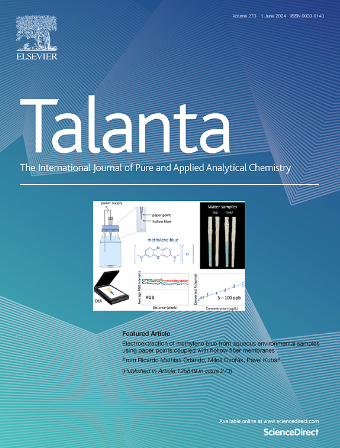集成传感器平台,实时监测硝酸盐,铵,温度和pH在水生环境
IF 6.1
1区 化学
Q1 CHEMISTRY, ANALYTICAL
引用次数: 0
摘要
本研究报告了一种集成电化学传感器平台的开发和特性,用于实时,同时检测水生环境中的硝酸盐,铵,温度和pH。硝酸和铵传感器分别采用定制的铜(Cu)和聚苯胺(PANI)电极,在1 ~ 100 mg/L的硝酸盐和0.05 ~ 10 mg/L的铵的检测范围内具有很高的灵敏度。校准图显示,两种传感器的线性响应良好(R2 = 0.98),硝酸盐和铵的检出限分别为0.84 mg/L和0.02 mg/L。该平台的特点是其多参数检测能力,通过补偿影响离子检测的环境变化,实时测量温度和pH值,从而提供离子测量的上下文准确性。结果表明,该平台对水中常见干扰具有较强的选择性和稳定性,证明了该平台用于现场环境监测的可靠性。将所有传感器元件集成到单个柔性基板上,并将其封装在防水3d打印外壳中,实现现场应用和连续数据收集,并实时传输到远程服务器进行监控。该综合系统被部署在一个循环水养殖系统中,在24小时内监测硝酸盐和铵的水平。与商用检测试剂盒相比,该传感器具有较高的精度,硝酸盐传感器的均方根误差为2.64 mg/L NO3−-N (R2 = 0.83),铵传感器的均方根误差为0.41 mg/L NH3-N (R2 = 0.84)。因此,这个多参数平台代表了一个创新的一步,为水产养殖和环境管理应用的可持续,准确和精确的水质评估。本文章由计算机程序翻译,如有差异,请以英文原文为准。

Integrated sensor platform for real-time monitoring of nitrate, ammonium, temperature, and pH in aquatic environments
This study reports the development and characterization of an integrated electrochemical sensor platform for real-time, simultaneous detection of nitrate, ammonium, temperature, and pH in aquatic environments. The nitrate and ammonium sensors utilized customized copper (Cu) and polyaniline (PANI) electrodes, respectively, which exhibited high sensitivity within a detection range from 1 to 100 mg/L for nitrate and 0.05–10 mg/L for ammonium. Calibration plots revealed excellent linear response for both sensors (R2 = 0.98), with detection limits of 0.84 mg/L for nitrate and 0.02 mg/L for ammonium. This platform is distinguished by its multi-parameter detection capability, where real-time measurements of temperature and pH offer contextual accuracy in ion measurements by compensating for environmental changes that affect ion detection. The results indicate robust selectivity and stability against common interferents in water, demonstrating this platform's reliability for on-site environmental monitoring. The integration of all sensor elements onto a single flexible substrate, combined with encapsulation in a waterproof 3D-printed housing, enables field applications and continuous data collection, with real-time transmission to a remote server for monitoring. This integrated system was deployed in a recirculating aquaculture system to monitor nitrate and ammonium levels over a 24-h period. The sensors demonstrated high accuracy when compared to commercial test kits, with a root mean square error of 2.64 mg/L NO3−-N (R2 = 0.83) for the nitrate sensor and 0.41 mg/L NH3–N (R2 = 0.84) for the ammonium sensor. Hence, this multi-parametric platform represents an innovative step forward for sustainable, accurate, and precise water quality assessment for aquacultural and environmental management applications.
求助全文
通过发布文献求助,成功后即可免费获取论文全文。
去求助
来源期刊

Talanta
化学-分析化学
CiteScore
12.30
自引率
4.90%
发文量
861
审稿时长
29 days
期刊介绍:
Talanta provides a forum for the publication of original research papers, short communications, and critical reviews in all branches of pure and applied analytical chemistry. Papers are evaluated based on established guidelines, including the fundamental nature of the study, scientific novelty, substantial improvement or advantage over existing technology or methods, and demonstrated analytical applicability. Original research papers on fundamental studies, and on novel sensor and instrumentation developments, are encouraged. Novel or improved applications in areas such as clinical and biological chemistry, environmental analysis, geochemistry, materials science and engineering, and analytical platforms for omics development are welcome.
Analytical performance of methods should be determined, including interference and matrix effects, and methods should be validated by comparison with a standard method, or analysis of a certified reference material. Simple spiking recoveries may not be sufficient. The developed method should especially comprise information on selectivity, sensitivity, detection limits, accuracy, and reliability. However, applying official validation or robustness studies to a routine method or technique does not necessarily constitute novelty. Proper statistical treatment of the data should be provided. Relevant literature should be cited, including related publications by the authors, and authors should discuss how their proposed methodology compares with previously reported methods.
 求助内容:
求助内容: 应助结果提醒方式:
应助结果提醒方式:


